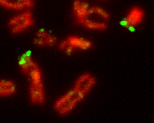拟常染色体区

拟常染色体区(英语:pseudoautosomal region),又称伪体染色体区,是在高等动物性染色体(即X染色体和Y染色体)上的一段同源序列,分为PAR1和PAR2两部分[1],拟常染色体区上已发现至少29个基因[2]。
拟常染色体区是X染色体和Y染色体间唯一可发生互换的位置,这也是它的名称由来,由于会发生互换的是常染色体,X染色体和Y染色体一般是没有互换的现象,只有在拟常染色体区反常地出现了互换,导致男性和女性都带有两个该区域基因的复本。这使拟常染色体区的基因表达类似常染色体,而非性染色体的伴性遗传模式,因而得名[3][4]。
位置
[编辑]
| 名称 | 染色体 | 起始位点 | 结束位点 | 带[6] |
|---|---|---|---|---|
| PAR1 | X染色体 | 10,001 | 2,781,479 | Xp22 |
| Y染色体 | 10,001 | 2,781,479 | Yp11 | |
| PAR2 | X染色体 | 155,701,383 | 156,030,895 | Xq28 |
| Y染色体 | 56,887,903 | 57,217,415 | Yq12 |
拟常染色体区在GRCh37的位置是:
| 名称 | 染色体 | 起始位点 | 结束位点 |
|---|---|---|---|
| PAR1 | X染色体 | 60,001 | 2,699,520 |
| Y染色体 | 10,001 | 2,649,520 | |
| PAR2 | X染色体 | 154,931,044 | 155,260,560 |
| Y染色体 | 59,034,050 | 59,363,566 |
功能与机制
[编辑]对一般X染色体上的基因而言,女性在两个X染色体各有一个复本,男性则只有在唯一的X染色体上有基因,Y染色体的对应区域则没有;而在Y染色体上的基因则只有男性拥有,女性因没有Y染色体而没有这些基因。但男性和女性都拥有两个拟常染色体区基因的复本,男性是在X染色体与Y染色体分别有一个,女性则是在两个X染色体各有一个,这种现象使拟常染色体区的基因遗传、表现模式都和常染色体的基因相同,而不同于邻近的性染色体基因。
基因
[编辑]
拟常染色体区共分PAR1和PAR2两区块,这两个区块被认为是独立演化出来的[7]。目前共已发现29个基因。
PAR1
[编辑]以下是目前已发现在人类拟常染色体区PAR1区域的基因,共计16个。在老鼠基因体中,有些PAR1的转基因到了常染色体[8]。
- ASMT,控制乙酰复合胺O-甲基转移酶(Acetylserotonin O-methyltransferase),促进褪黑素生合成的酵素产生[9]。
- CSF2RA,控制粒细胞-巨噬细胞集落刺激因子(Granulocyte macrophage colony-stimulating factor)之受体的生成,与造血干细胞的诱导分化有关[15]。
- PPP2R3B,可翻译出一种蛋白磷酸酶(Protein phosphatase 2),该蛋白质为四种主要的丝氨酸-苏氨酸磷酸酶(Ser/Thr phosphatases)之一,也和细胞成长的负回馈有关[21]。
PAR2
[编辑]以下是目前已发现在拟常染色体区PAR2区域的基因,共计3个,另有一个受关注的伪基因。
病理学
[编辑]X与Y染色体在拟常染色体区的基因互换和男性的减数分裂有所关联,因此X与Y染色体配对错误的细胞无法完成减数分裂。拟常染色体区的基因突变或变性都会影响X与Y染色体的配对及互换,进而导致男性无法生育。
拟常染色体区上的基因都可以躲过X染色体去激活,也就是当X染色体被去激活成巴尔氏体后,其上拟常染色体区的基因仍可表现,这造成了XXY、XO、XXXY等性染色体数目异常者的剂量问题,使他们产生疾病[3]。例如PAR1区域的SHOX基因控制身体发育,XO的透纳氏症患者缺少一个SHOX基因的复本,将导致其身材特别矮小。另外SHOX基因的缺陷也可能造成Léri-Weill软骨骨生成障碍综合征[27]及马德隆畸形症(Madelung's deformity)等侏儒症。
参考文献
[编辑]- ^ Helena Mangs A, Morris BJ. The Human Pseudoautosomal Region (PAR): Origin, Function and Future. Curr. Genomics. April 2007, 8 (2): 129–36. PMC 2435358
 . PMID 18660847. doi:10.2174/138920207780368141.
. PMID 18660847. doi:10.2174/138920207780368141.
- ^ Blaschke RJ, Rappold G. The pseudoautosomal regions, SHOX and disease. Curr Opin Genet Dev. 2006, 16 (3): 233–9. PMID 16650979. doi:10.1016/j.gde.2006.04.004.
- ^ 3.0 3.1 班布里基(David Bainbridge)著, 陈雅茜 译. 《X染色體 命運的幕後黑手》. 天下文化出版社. 2004年10月. ISBN 986-417-380-4 (中文(台湾)).
- ^ 4.0 4.1 Ciccodicola A, D'Esposito M, Esposito T; et al. Differentially regulated and evolved genes in the fully sequenced Xq/Yq pseudoautosomal region. Hum. Mol. Genet. February 2000, 9 (3): 395–401 [2011-02-18]. PMID 10655549. doi:10.1093/hmg/9.3.395. (原始内容存档于2019-09-15).
- ^ Genome Reference Consortium. Human genome overview GRCh38.p10. 2017-01-06 [2017-05-10]. (原始内容存档于2016-10-09).
- ^ Pseudoautosomal regions Gene Family. HUGO Gene Nomenclature Committee. [2017-05-11]. (原始内容存档于2017-07-11).
- ^ Charchar FJ, Svartman M, El-Mogharbel N; et al. Complex events in the evolution of the human pseudoautosomal region 2 (PAR2). Genome Res. February 2003, 13 (2): 281–6 [2011-02-18]. PMC 420362
 . PMID 12566406. doi:10.1101/gr.390503. (原始内容存档于2019-09-15).
. PMID 12566406. doi:10.1101/gr.390503. (原始内容存档于2019-09-15).
- ^ Levy MA, Fernandes AD, Tremblay DC, Seah C, Bérubé NG. The SWI/SNF protein ATRX co-regulates pseudoautosomal genes that have translocated to autosomes in the mouse genome. BMC Genomics. 2008, 9: 468 [2011-02-18]. PMC 2577121
 . PMID 18842153. doi:10.1186/1471-2164-9-468. (原始内容存档于2011-05-25).
. PMID 18842153. doi:10.1186/1471-2164-9-468. (原始内容存档于2011-05-25).
- ^ Rodriguez IR, Mazuruk K, Schoen TJ, Chader GJ. Structural analysis of the human hydroxyindole-O-methyltransferase gene. Presence of two distinct promoters. J. Biol. Chem. December 1994, 269 (50): 31969–77 [2011-02-18]. PMID 7989373. (原始内容存档于2003-10-04).
- ^ Ried K, Rao E, Schiebel K, Rappold GA. Gene duplications as a recurrent theme in the evolution of the human pseudoautosomal region 1: isolation of the gene ASMTL. Hum Mol Genet. Dec 1998, 7 (11): 1771–8. PMID 9736779. doi:10.1093/hmg/7.11.1771.
- ^ Bernard G, Raimondi V, Alberti I, Pourtein M, Widjenes J, Ticchioni M, Bernard A. CD99 (E2) up-regulates alpha4beta1-dependent T cell adhesion to inflamed vascular endothelium under flow conditions. European journal of immunology. October 2000, 30 (10): 3061–5. PMID 11069091. doi:10.1002/1521-4141(200010)30:10<3061::AID-IMMU3061>3.0.CO;2-M.
- ^ Bernard G, Breittmayer JP, de Matteis M, Trampont P, Hofman P, Senik A, Bernard A. Apoptosis of immature thymocytes mediated by E2/CD99. Journal of immunology (Baltimore, Md. : 1950). March 1997, 158 (6): 2543–50. PMID 9058785.
- ^ Oh KI, Kim BK, Ban YL, Choi EY, Jung KC, Lee IS, Park SH. CD99 activates T cells via a costimulatory function that promotes raft association of TCR complex and tyrosine phosphorylation of TCR zeta. Experimental & molecular medicine. April 2007, 39 (2): 176–84 [2011年2月18日]. PMID 17464179. (原始内容存档于2011年7月26日).
- ^ Entrez Gene: CRLF2 cytokine receptor-like factor 2.
- ^ Nicola NA, Metcalf D. Binding of 125I-labeled granulocyte colony-stimulating factor to normal murine hemopoietic cells. J. Cell. Physiol. 1985, 124 (2): 313–21. PMID 3876343. doi:10.1002/jcp.1041240222.
- ^ Persson B, Kallberg Y, Bray JE, Bruford E, Dellaporta SL, Favia AD, Duarte RG, Jörnvall H, Kavanagh KL, Kedishvili N, Kisiela M, Maser E, Mindnich R, Orchard S, Penning TM, Thornton JM, Adamski J, Oppermann U. The SDR (short-chain dehydrogenase/reductase and related enzymes) nomenclature initiative. Chem. Biol. Interact. November 2008, 178 (1-3): 94–8. PMC 2896744
 . PMID 19027726. doi:10.1016/j.cbi.2008.10.040.
. PMID 19027726. doi:10.1016/j.cbi.2008.10.040.
- ^ Vawter MP, Harvey PD, DeLisi LE. Dysregulation of X-linked gene expression in Klinefelter's syndrome and association with verbal cognition. Am. J. Med. Genet. B Neuropsychiatr. Genet. September 2007, 144B (6): 728–34. PMC 2094046
 . PMID 17347996. doi:10.1002/ajmg.b.30454.
. PMID 17347996. doi:10.1002/ajmg.b.30454.
- ^ Stomski, F C; Sun Q, Bagley C J, Woodcock J, Goodall G, Andrews R K, Berndt M C, Lopez A F. Human interleukin-3 (IL-3) induces disulfide-linked IL-3 receptor alpha- and beta-chain heterodimerization, which is required for receptor activation but not high-affinity binding. Mol. Cell. Biol. (UNITED STATES). Jun 1996, 16 (6): 3035–46. ISSN 0270-7306. PMC 231298
 . PMID 8649415.
. PMID 8649415.
- ^ Entrez Gene: P2RY8 purinergic receptor P2Y, G-protein coupled, 8.
- ^ Skaletsky H, Kuroda-Kawaguchi T, Minx PJ; et al. The male-specific region of the human Y chromosome is a mosaic of discrete sequence classes. Nature. June 2003, 423 (6942): 825–37. PMID 12815422. doi:10.1038/nature01722.
- ^ Entrez Gene: PPP2R3B protein phosphatase 2 (formerly 2A), regulatory subunit B, beta.
- ^ SHOX - short stature homeobox - Genetics Home Reference. U.S. National Library of Medicine. [2008-02-18 date = 2005-09-01]. (原始内容存档于2007-10-12).
- ^ Palmieri F. The mitochondrial transporter family (SLC25): physiological and pathological implications. Pflugers Arch. February 2004, 447 (5): 689–709. PMID 14598172. doi:10.1007/s00424-003-1099-7.
- ^ Tippett P, Ellis NA. The Xg blood group system: a review. Transfus Med Rev. October 1998, 12 (4): 233–57 [2011-02-18]. PMID 9798268. doi:10.1016/S0887-7963(98)80001-1. (原始内容存档于2020-07-28).
- ^ Mann JJ, Cahan A, Gelb AG, et al. A sex-linked blood group. Lancet. 1962;i:8.
- ^ WASH6P. [2009-01-05]. (原始内容存档于2012-10-24).
- ^ Renata de Lima1; Cristina Forti Iamada; Luciana Oliveira Silva; Maricilda Palandi de Mello; Andréa Trevas Maciel-Guerra. An illustrative case of Léri-Weill dyschondrosteosis. Centro de Biologia Molecular e Engenharia Genética, Universidade Estadual de Campinas, Campinas, SP, Brazil; Departamento de Genética Médica, Faculdade de Ciências Médicas, Universidade Estadual de Campinas, Campinas, SP, Brazil; Departamento de Pediatria, Faculdade de Ciências Médicas, Universidade Estadual de Campinas, Campinas, SP, Brazil. 2008-11-19 [2011-02-18]. ISSN 1415-4757. doi:10.1590/S1415-47572008005000017. (原始内容存档于2017-12-02) (英语).
